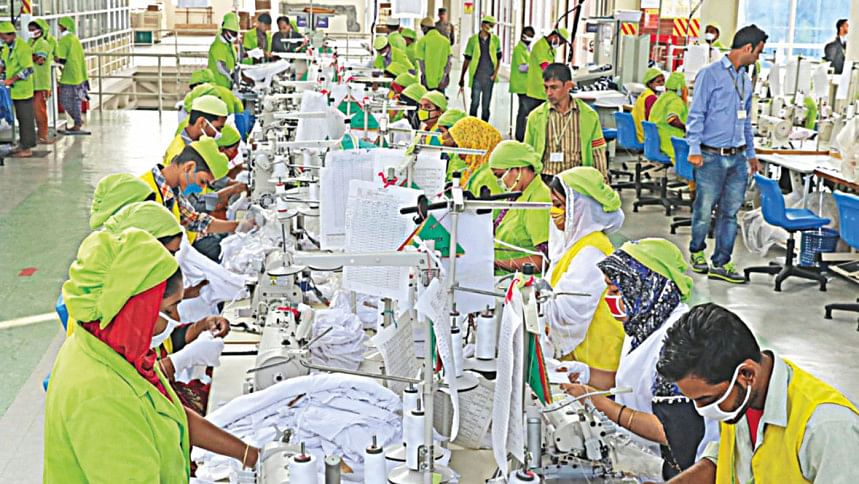Employment Injury Protection Scheme: A new horizon to workers’ social protection

A study by ILO reveals that over 11,000 workers suffer fatal accidents and a further 24,500 die from work-related diseases across all sectors each year in Bangladesh. The study also estimated that a further 8 million workers suffer injuries at work – many of which result in permanent disability. Despite this, none of the employers has faced severe legal consequences or has adequately compensated the injured workers or the dependents of the deceased workers. However, ever since the Rana Plaza tragedy occurred in 2013, rights organizations have given considerable effort to improve the compensation mechanism in Bangladesh through amendments in the BLA and initiation to establish an Employment Injury Protection Scheme.
It is globally recognised that the majority of these tragedies occur due to the negligence or non-compliance with law or ineffectiveness of stakeholders and could be avoided if the employers complied with the minimum safety requirements mentioned in the Bangladesh Labour Act, 2006 (BLA) and Bangladesh Labour Rules 2015 (BLR).
As per the Bangladesh Labour Act 2006, as amended up to 2018, a worker with a permanent disability is entitled to a compensation package of one lac twenty-five thousand taka while anyone incurring a temporary disability is entitled to compensation assessed for the period of their disability or one year whichever is less. The amount of compensation payable for the first two months will be the entire monthly wage, the amount of compensation for the next two months will be two-thirds of the monthly wages and for the remaining months, it will be half of the monthly wages.
This is apparent that the current compensation payable under the BLA is not adequate and calls for a scheme that ensures that injured workers and dependents of the deceased are effectively compensated, both financially and in respect of medical and other relevant care. Since 2015, ILO has been trying to establish a fund to ensure long-term protection for the workers against workplace accidents and occupational diseases in Bangladesh. In pursuit of this, the ILO proposed to establish a national Employment Injury Protection Scheme (EIPS) based on the principles of ILO Convention 121 on Employment Injury Benefits but the Government is yet to put the mechanism in place.
ILO Convention 121 recognises the importance of an integrated approach for improving working conditions, limiting the consequences of work-related injuries and facilitating the reintegration of individuals with disabilities in the labour market; for such purposes, this Convention requires the State to take measures to prevent employment injuries, provide rehabilitation services and ensure that displaced workers find appropriate re-employment. As per the ILO C 121, workers are entitled to compensation by in-kind benefits for medical treatment and rehabilitation services, and in-cash benefits for income loss caused by workplace injuries and diseases, regardless of the negligence of their employers. The Convention specifies, in case of incapacity for work or invalidity, periodical payment should be at least 60% of the former earnings of a worker; in case of death of the breadwinner, the compensation should be at least 50% of former earnings of wage of an unskilled worker.
Under the Convention, State shall accept general responsibility for collection of contributions, payment of benefits, and proper administration of the concerned institutions. To fulfill the mandate, Bangladesh Government can form a tripartite committee consisting of constituents from government, workers and employers, with the required support of international partners. In terms of fund collection, the implementing agencies can adopt an approach where the total costs would be shared amongst all relevant stakeholders, both at the national and international levels. The employer can contribute a fixed percentage of the wages of individual workers, for instance, the scheme can require the employers to contribute 0.50% of the monthly wages of a worker. Meaning, if a worker earns 10,000 BDT a month, the employer would contribute 50 BDT a month to the fund for an individual worker. This amount should be exclusively paid by the employer, not to be deducted from the workers' wages. Also, there should be scope for the international buyers, brands or donor organisations to voluntarily contribute to the scheme.
Compensation payable by the EIPS fund under Convention 121 should be in addition to the compensation payable by the central fund or the group insurance under the BLA. However, there should be a provision that requires the workers to give up compensation-related litigations under other legislations in order to receive financial grants from the scheme.
Apart from financial grants, the scheme should initiate a vocational rehabilitation program to reintegrate workers who acquired a disability due to workplace injuries. Currently, BLA and BLR have no explicit provisions regarding rehabilitation and to date, no considerable steps have been taken by the Government agencies to rehabilitate the injured workers. The EIPS can provide a decent opportunity to the injured workers to facilitate their return to work. On the other hand, implementation of the scheme would protect the employers against financial consequences of workplace accidents and diseases through collective risk-sharing, that is, the employers will collectively contribute to the scheme for compensation and rehabilitation alleviating the burden on individual employers.
The writer is a Research Associate at Institute for Inclusive Policy.

 For all latest news, follow The Daily Star's Google News channel.
For all latest news, follow The Daily Star's Google News channel. 



Comments